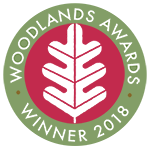A lunch-hour trip to Rais yesterday resulted in a wealth of knowledge from our lovely West Sussex Woodland Officer, Dave Rogers. Very reassuring to know that the work we have done so far is absolutely the right thing we should have been focusing on... Rhodie clearance of course! We wandered down to the clearing camp, taking photos along the way and Dave asking questions about our intentions for the wood. He was impressed with some of the Oaks and agreed the entrance Holly was a great specimen - although he did warn that Holly can spread rapidly if not kept in check. He offered advice on the best way to get the Rhodies under control and how we are in a good position to obtain a "Woodland Improvement Grant" to help. Rhodies are deemed to destroy the health of woodlands and so financial help is available to those that apply with a written management plan. Dave is going to email me with all the details and instructions for the steps I must take to get there. The first step is to apply for an "SBI" number, then a "CPH" number which will allow me to register the land with the Rural Payment Agency (RPA). Sounds complicated, but promising at the same time.
Next Dave pointed out the Alder Carr, which he says would be good for making charcoal should we wish to, it also coppices really well which is something we should consider after the Rhodies have been tamed to allow light to the woodland floor and give the wildflowers a chance to shine.
It was also news to me that there are apparently 6 or so different species of Ash in this country, a few of which we have, including one that he was unable to identify, so he took a twig and some leaves to get a better idea back at the commission.
He advised on the Ash tree which has grown into a Rowan and how perhaps there is a chance we can still save the Rowan if we employ the services of an experienced tree surgeon who is willing to section up the offending branch and bring it down safely.
He also made me realise that the water courses that are at the bottom of ravine type formations that we have been referring to as streams are actually known as Ghylls. We clearly have so much to learn! but thankfully I feel a renewed confidence and enthusiasm for the Rhodie clearance now - it seems that working in sections, starting with hand cutting, and pulling the roots out where we can, then cutting them down to size is definitely the best way to do it and certainly the most ecologically sound. Unfortunately this will not destroy them and the best way to do that is to invest in some industrial strength glyphosate (Round Up) and a knapsack sprayer which we can wander round spraying the regrowth with next June. Hopefully by then we will have some grant money to help as the size of the infestation we have at Rais is not going to be cheap.


